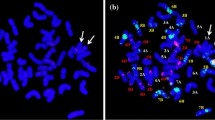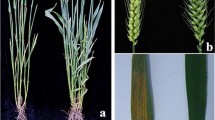Abstract
A wheat (Triticum aestivum L.) line 4844 with superior numbers of florets and grains per spike was derived from the cross between Fukohokomugi wheat and Agropyron cristatum (L.) Gaertn. In order to determine the genetic control of floret and kernel number per spike in this line, chromosome addition and substitution lines that were derived from line 4844 were characterized by means of in situ hybridization, microsatellite (SSR), and gliadin analyses. Genomic in situ hybridization analysis with biotinylated P genomic DNA of A. cristatum as a probe demonstrated that the increased number of florets and grains in a spike was associated with the introgression of an A. cristatum chromosome. Fluorescence in situ hybridization, using a repetitive sequence, pAs1, derived from Aegilops squarrosa L., indicated the replacement of chromosome 6D of wheat in the wheat-A. cristatum chromosome substitution lines. This was confirmed by microsatellite analyses with wheat SSR markers specific for chromosome 6D, suggesting that the A. cristatum chromosome was homoeologous to group 6 and was therefore designated as 6P. This conclvsion was further confirmed by amplification using EST-SSR markers and gliadin analysis. The increased number of florets and kernels within a spike of the wheat-A. cristatum hybrids thus was controlled by gene(s) located on A. cristatum chromosome 6P.




Similar content being viewed by others
References
Ahmad F, Comeau A (1991) A new intergeneric hybrid between Triticum aestivum L. and Agropyron fragile (Roth.) Candargy: variation in A. fragile for suppression of wheat Ph-locus activity. Plant Breed 106:267–283
Barber HN, Driscoll CJ, Long PM, Vickery RS (1968) Protein genetics of wheat and homoeologous relationships of chromosomes. Nature 218:450–452
Chapman CHD (1989) Collection strategies for wild relatives. In: Brown AHD, Frankel OH, Marshall DR, Williams JT (eds) The use of plant genetic resources. Cambridge University Press, Cambridge, pp 269–279
Chen HM, Li LZ, Wei XY, Li SS, Lei TD, Hu HZ, Wang HG, Zhang XS (2005) Development, chromosome location and genetic mapping of EST-SSR markers in wheat. Chin Sci Bull 50:2328–2336
Chen Q, Jahier J, Bernard M (1994) Identification of wheat-Agropyron cristatum monosomic addition lines by RFLP analysis using a set of assigned wheat DNA probes. Theor Appl Genet 89:70–75
Chen Q, Jahier J, Cauderon Y (1989) Production and cytogenetic studies of hybrids between Triticum aestivum L. Thell. and Agropyron cristatum (L.) Gaertn. C. R. Acad Sci Paris III 308:425–430
Chen Q, Jahier J, Cauderon Y (1990) Intergeneric hybrids between Triticum aestivum and three crested wheatgrasses: Agropyron mongolicum, A. michnoi, A. desertorum. Genome 33:663–667
Dellaport SL, Wood J, Hicks JB (1983) A rapid method for DNA extraction from plant tissue. Plant Mol Biol Rep 1:19–21
Dewey DR (1984) The genomic system of classification as a guide to intergeneric hybridization with the perennial Triticeae. In: Gustafson JP (ed) Gene manipulation in plant improvement. Proceedings of 16th Stadler Genetics Symposium, New York, pp 209–279
Dong YS, Zhou RH, Xu SJ, Cauderon Y, Wang RC (1992) Desirable characteristics in perennial Triticease collected in China for wheat improvement. Hereditas 116:176–178
Dou QW, Chen PD (2003) Cytological and molecular identification of alien chromatin in giant spike wheat germplasm. Acta Bot Sin 45:1109–1115
Driscoll CJ (1983) Third compendium of wheat alien chromosome lines. In: Supplement to the 6th international wheat genetics symposium, pp 286–290
Dvořak J (1980) Homoeology between Agropyron elongatatum chromosomes and Triticum aestivum chromosomes. Can J Genet Cytol 22:237–259
Frederic JR Bauer PJ. (2000) Physiological and numerical components of wheat yield. In: Satorre EH Slafer GA (eds) Wheat ecology and physiology of yield determination, chap 3. Food Products Press New York, pp 45–65
Guo BZ (1987) Chinese plant log. Chinese Scientific Press, Beijing
Gupta PK (1971) Homoeologous relationship between wheat and rye chromosomes. Present status. Genetica 42:199–213
Han FP, Liu B, Fedak G, Liu ZH (2004) Genomic constitution and variation in five partial amphiploids of wheat-Thinopyrum intermedium as revealed by GISH, multicolor GISH and seed storage protein analysis. Theor Appl Genet 109:1070–1076
Jauhar PP (1992) Chromosome pairing in hybirds between hexaploid bread wheat and tetraploid crested wheatgrass (Agropyron cristatum). Hereditas 116:107–109
Khan K, Hamada AS, Patek J (1985) Polyacrylamide-gel electrophoresis for wheat variety identification: effect of variables on gel properties. Cereal Chem 62:310–313
Korzun V, Börner A, Worland AJ, Law CN, Röder MS (1997) Application of microsatellite markers to distinguish inter-varietal chromosome substitution lines of wheat (Triticum aestivum L.). Euphytica 95:149–155
Li LH, Dong YS (1991a) Production and cytogenetic study of intergeneric hybrids between Triticum aestivum and Agropyron desertorum. Sci China (Ser B) 34:45–51
Li LH, Dong YS (1991b) Hybridization between Triticum aestivum L. and Agropyron michnoi Roshev. 1. Production and cytogenetic study of F1 hybrid. Theor Appl Genet 81:312–316
Li LH, Dong YS (1993) Progress in studies of Agropyron Gaertn. Hereditas 15: 45–48
Li LH, Dong YS, Zhou RH, Li XQ, Li P, Yang XM (1995) Cytogenetics and self-fertility of intergeneric hybrids between Triticum aestivum L. and Agropyron cristatum (L.) Gaertn. Chin J Genet 22:105–112
Li LH, Yang XM, Li XQ, Dong YC, Chen XM (1998) Introduction of desirable genes from Agropyron cristatum into common wheat by intergeneric hybridization. Sci Agric Sin 31:1–6
Li ZS, Rong S, Cheng SY, Zhong G.C, Mu SM (1985) Wheat wide hybridization. Chinese Scientific Press, Beijing
Limin AE, Fowler DB (1990) An interspecific hybrid and amphiploid from Triticum aestivum crosses with Agropyron cristatum and Agropyron desertorum. Genome 33:581–584
Little TM, Hills FJ (1978) Agricultural experimentation: design and analysis. Wiley, New York
Millet E (1983) Breeding for large number of spikelets per spike in wheat. In: Sakamoto S. Proceedings of the 6th international wheat genetics symposium. Kyoto University, Kyoto, pp 623–628
Mukai Y, Namkahara Y, Yamamoto M (1993) Simultaneous discrimination of the three genomes in hexaploid wheat by multicolor in situ hybridization using total genomic and high repeated DNA probes. Genome 36:489–494
Pedersen C, Langridge P (1997) Identification of the entire chromosome complement of bread wheat by two-color FISH. Genome 40:589–593
Peng ZS, Yang J, Wei SH, Zeng JH. (2004) Characterization of the common wheat (Triticum aestivum L.) mutation line producing three pistils in a floret. Hereditas 141:15–18
Pestsova E, Ganal MW, Röder MS (2000a) Isolation and mapping of microsatellite markers specific for the D genome of bread wheat. Genome 43:689–697
Pestsova E, Salina E, Börner A, Korzun V, Maystrenko OI, Röder S. (2000b) Microsatellites confirm the authenticity of intervarietal chromosome substitution lines of wheat (Triticum aestivum L.). Theor Appl Genet 101:95–99
Rayburn AL, Gill BS (1986a) Isolation of a D genome specific repeated DNA sequence from Aegilops squarrosa. Plant Mol Biol Rep 4:102–109
Rayburn AL, Gill BS (1986b) Molecular identification of the D-genome chromosomes of wheat. J Hered 77:253–255
Röder MS, Korzun V, Wendehake K, Planschke J, Tixier MH, Leroy P, Ganal MW (1998) A microsatellite map of wheat. Genetics 149:2007–2023
Sears ER (1968) Relation of chromosome 2A, 2B and 2C with their rye homoeologoue. In: Proceedings of 3rd international wheat genetics symposium, pp 53–60
Wang ZG, An TG, Li JM, Marta ML, Ji J, Zhong GC, Mu SM (2004) Fluorescent in situ hybridization analysis of rye chromatin in the background of “Xiaoyan No. 6”. Acta Bot Sin 46:436–442
Yen C, Zheng YL, Yang JL (1993) An ideotype for high yield breeding in theory and practice. In: Proceedings of 8th international wheat genetics symposium. Agricultural Sci-tech Press, Beijing, pp 1113–1117
Zheng YL, Yen C, Yang LJ (1993) Monosomic analysis for total and sterile floret number per spike in the multispikelet line 10-A of common wheat. Wheat Inf Serv 77:25–28
Acknowledgment
The financial supports provided by the Ministry of Science and Technology of China (project numbers 2006CB101700 and 2004BA525B03) are gratefully appreciated.
Author information
Authors and Affiliations
Corresponding author
Additional information
Communicated by M. Morell.
Rights and permissions
About this article
Cite this article
Wu, J., Yang, X., Wang, H. et al. The introgression of chromosome 6P specifying for increased numbers of florets and kernels from Agropyron cristatum into wheat. Theor Appl Genet 114, 13–20 (2006). https://doi.org/10.1007/s00122-006-0405-0
Received:
Accepted:
Published:
Issue Date:
DOI: https://doi.org/10.1007/s00122-006-0405-0




